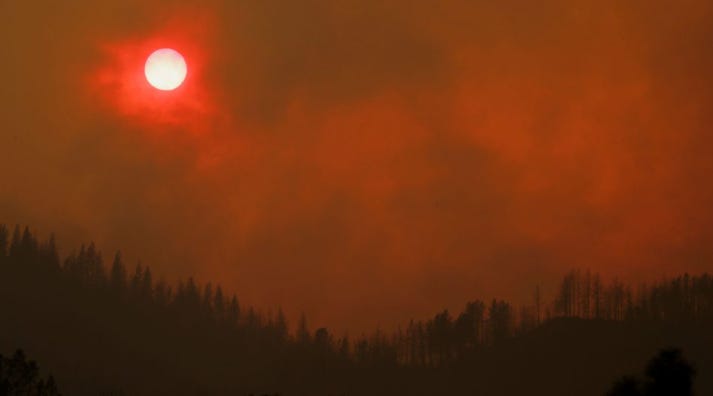There’s a swimming hole near where I grew up in Northern California where the creek is shallow and wide. It’s a great place for families to go on sweltering summer days, a spot where little kids can splash around and enjoy nature and adults can get their feet wet and skip a few stones. Scout troops sometimes camp there.
It’s known as Alligator Hole, and it’s located outside my home-town of Chico, in what locals call the “upper park.” Upper Bidwell Park is the eastern section of a sprawling and grand municipal space that runs green and lush through town before jumping Manzanita Avenue and transforming into golden, rocky wilderness as it stretches into the foothills of the Sierra Nevadas.
Last Thursday, near Alligator Hole, someone lit his car on fire and pushed it into a 60-foot gully. The inferno that incident ignited has become California’s biggest fire of the year and the fifth largest blaze in the state’s history. As I write this, only 18 percent of it is contained, and it’s already decimated nearly 400,000 acres. The blaze, dubbed the Park Fire, is so giant that, chillingly, you can watch it burn from space.
Monster fires like this are now commonplace in California. When I was a child, autumns were always marked by the smell of smoke, but that was only because people were burning leaves—a practice that now requires a special permit. I never saw a smoke-screened sun looking like a dark crimson disk in the sky until I was well into adulthood, and a visit home coincided with a giant blaze in the Sierra Nevadas. But during fire season, this is now a fairly ordinary sight in the West, where over the past half century, the amount of acreage burned by wildfire has increased 600 percent.
So far, the Park Fire has destroyed or damaged more than 300 structures and is burning in four counties. Among the thousands of people displaced are those who were also tragically affected six years ago when another mega-blaze erupted only a few miles away. In 2018, the Camp Fire all but destroyed the nearby town of Paradise, killing 85 people and demolishing nearly 20,000 homes and other structures, including hospitals and schools. My mom grew up in Paradise and watched her elementary school burn down on live TV from her home in New Jersey. She died two months later, and I believe the horrors of the Camp Fire helped hasten the stroke or heart attack that ultimately killed her.
Fires can do a lot of damage.
The Park Fire took off so quickly, fire crews didn’t stand a chance. One official called its explosive spread “kind of unparalleled.” Fomenting its preternatural fury and speed were the usual suspects: hot weather, wind and an abundance of fuel.
To understand these conditions, we have to go back in time.
It had been a wet winter in that part of California, enough to replenish the reservoirs, lakes and creeks and restore a sense of relief across a region that has weathered more than its share of crippling drought. The merciful rain nurtured new growth, blanketing the upper park with green.
Then summer arrived. With a vengeance.
This chart shows Chico’s high and low temperatures from June 30 to July 27.
That’s 20 days of temperatures over 100 in a single month. (And it wasn’t just brutal in Chico; the first 10 days of July were so hot, they set records all over the West.)
With the scorching heat came dry air that baked all the new growth, turning it into kindling. Then the wind kicked up.
“That made prime conditions for fire,” one official told Bloomberg News “The fuel is still there, and the weather is too.”
Three years ago, yet another megafire struck this region. It was called the Dixie Fire, and authorities fear the Park Fire could follow a similar trajectory. The Dixie Fire, which also began in the heat of a record-setting July, destroyed close to a million acres before it was fully extinguished, gulp, the following October. The Dixie fire would go down as the largest single wildfire in recorded California history.
Fires are a natural part of California’s ecosystem, but there’s no question that increasing temperatures are translating into bigger and more frequent burns, extending fire season by as much as three months. As I write this, there are nearly 100 wildfires ablaze in the West alone.
And California summers will only get hotter. According to some projections, daily average high temperatures are expected to rise to 5.8°F by the middle of the century. When today’s toddlers are in their 80s, this average could be as much as 8.8°F. Wildfires could increase accordingly, becoming 50% more frequent by the year 2100.
That an arsonist ignited the Park Fire is an irony that only adds insult to these fraught times. Because of previous convictions, the accused could spend the rest of his life in prison, a fate plenty of Californians feel he deserves.
But no matter how they start, megablazes like the Park Fire are now inevitable. I should expect them, but each time they occur, my heart still aches.
And this one, so close to home, hits me especially hard.








This is heartbreaking and becoming all too common. Another reminder how the approach to forestry to prevent forest fires and their wild spread has been abandoned and changed over time, leaving nature exposed to these blazes in a much bigger way.
This is just so poignantly and thoughtfully written, and meticulously researched. Not a happy read but important. I shared it with my friend who does fire mitigation education. Xoxo